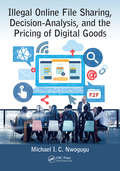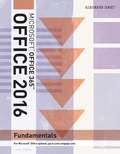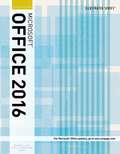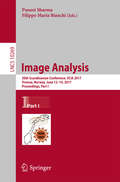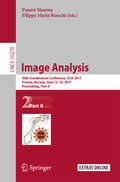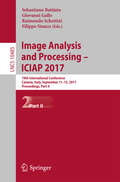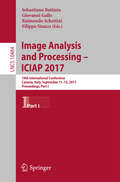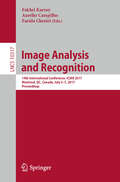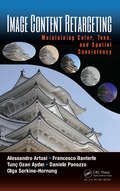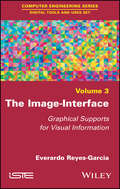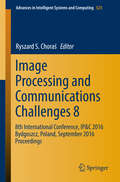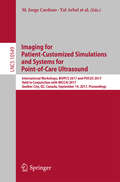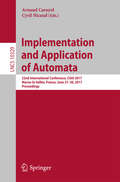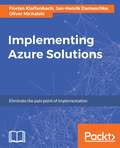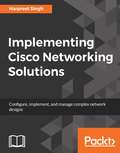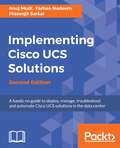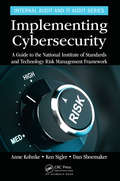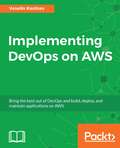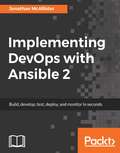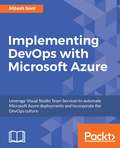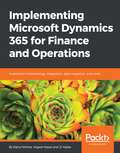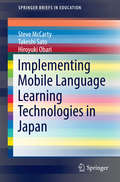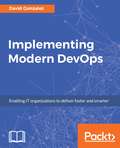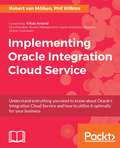- Table View
- List View
Illegal Online File Sharing, Decision-Analysis, and the Pricing of Digital Goods
by Michael I. NwoguguIllegal online file sharing costs companies tens of billions of dollars of lost revenues around the world annually and results in lost productivity, various psychological issues, and significant reduction of incentives to create and innovate. Legislative, technical, and enforcement efforts have failed. This book presents psychological theories about why people illegally share files online; analyzes and characterizes optimal sanctions for illegal online file sharing; introduces new models for pricing of network-access and digital-content to help reduce illegal online file sharing; introduces new content control and P2P systems; and explains why game theory does not work in pricing of network access.
Illustrated Microsoft® Office 365 And Office 2016: Fundamentals (Illustrated Series)
by Marjorie Hunt Barbara ClemensBoth computer rookies and pros can master Microsoft Office 2016 applications quickly and efficiently with this new book in the popular Illustrated Series -- <P><P>ILLUSTRATED MICROSOFT OFFICE 365 & Office 2016: FUNDAMENTALS. Using a concise, focused approach and user-friendly format, the Illustrated Series features a hallmark two-page layout that allows the reader to see an entire task without turning the page. <P><P>Skills are accessible and easy to follow with Learning Outcomes that outline the key concepts in each lesson. Larger full-color images reflect exactly what readers should see on their own computer screens. <P><P>Each module begins with a brief overview of the principles of the lesson and introduces an updated case study for further application. <P><P>Readers can count on ILLUSTRATED MICROSOFT OFFICE 365 & Office 2016: FUNDAMENTALS to perfect the skills they need now and on the job.
Illustrated Microsoft Office 365 and Office 2016 Introductory
by David W. Beskeen Carol M. Cram Jennifer Duffy Lisa Friedrichsen Elizabeth Eisner RedingWhether you're a computer rookie or hot shot, you can master Microsoft Office 2016 applications quickly with ILLUSTRATED MICROSOFT OFFICE 2016 & OFFICE 365 INTRODUCTORY, part of the popular Illustrated Series. Using a focused, user-friendly format, a two-page layout allows you to work through an entire task without turning the page. The book's easy to follow presentation highlights Learning Outcomes that outline the skills in each lesson. Larger full-color screen images reflect exactly what you should see on your own computer. Each module begins with a brief overview of the principles of the lesson and introduces a case study for further application. New Productivity Apps visually introduce Microsoft OneNote, Sway, Office Mix and Edge using fun, hands-on activities. Companion Sways provide videos and step-by-step instructions to help you master each app. In addition, MindTap and SAM help you further focus your study for results now and success later on the job.
Illustrated Microsoft® Office 365TM & Office 2016: Introductory
by Beskeen Cram DuffyWhether you're a computer rookie or hot shot, you can master Microsoft Office 2016 applications quickly with ILLUSTRATED MICROSOFT OFFICE 2016 & OFFICE 365 INTRODUCTORY, part of the popular Illustrated Series. Using a focused, user-friendly format, a two-page layout allows you to work through an entire task without turning the page. The book's easy to follow presentation highlights Learning Outcomes that outline the skills in each lesson. Larger full-color screen images reflect exactly what you should see on your own computer. Each module begins with a brief overview of the principles of the lesson and introduces a case study for further application. New Productivity Apps visually introduce Microsoft OneNote, Sway, Office Mix and Edge using fun, hands-on activities. Companion Sways provide videos and step-by-step instructions to help you master each app. In addition, MindTap and SAM help you further focus your study for results now and success later on the job.
Image Analysis: 20th Scandinavian Conference, SCIA 2017, Tromsø, Norway, June 12–14, 2017, Proceedings, Part I (Lecture Notes in Computer Science #10269)
by Puneet Sharma and Filippo Maria BianchiThe two-volume set LNCS 10269 and 10270 constitutes the refereed proceedings of the 20th Scandinavian Conference on Image Analysis, SCIA 2017, held in Tromsø, Norway, in June 2017. The 87 revised papers presented were carefully reviewed and selected from 133 submissions. The contributions are structured in topical sections on history of SCIA; motion analysis and 3D vision; pattern detection and recognition; machine learning; image processing and applications; feature extraction and segmentation; remote sensing; medical and biomedical image analysis; faces, gestures and multispectral analysis.
Image Analysis: 20th Scandinavian Conference, SCIA 2017, Tromsø, Norway, June 12–14, 2017, Proceedings, Part II (Lecture Notes in Computer Science #10270)
by Puneet Sharma and Filippo Maria BianchiThe two-volume set LNCS 10269 and 10270 constitutes the refereed proceedings of the 20th Scandinavian Conference on Image Analysis, SCIA 2017, held in Tromsø, Norway, in June 2017. The 87 revised papers presented were carefully reviewed and selected from 133 submissions. The contributions are structured in topical sections on history of SCIA; motion analysis and 3D vision; pattern detection and recognition; machine learning; image processing and applications; feature extraction and segmentation; remote sensing; medical and biomedical image analysis; faces, gestures and multispectral analysis.
Image Analysis and Processing - ICIAP 2017: 19th International Conference, Catania, Italy, September 11-15, 2017, Proceedings, Part II (Lecture Notes in Computer Science #10485)
by Sebastiano Battiato, Giovanni Gallo, Raimondo Schettini and Filippo StancoThe two-volume set LNCS 10484 and 10485 constitutes the refereed proceedings of the 19th International Conference on Image Analysis and Processing, ICIAP 2017, held in Catania, Italy, in September 2017.The 138 papers presented were carefully reviewed and selected from 229 submissions. The papers cover both classic and the most recent trends in image processing, computer vision, and pattern recognition, addressing both theoretical and applicative aspects. They are organized in the following topical sections: video analysis and understanding; pattern recognition and machine learning; multiview geometry and 3D computer vision; image analysis, detection and recognition; multimedia; biomedical and assistive technology; information forensics and security; imaging for cultural heritage and archaeology; and imaging solutions for improving the quality of life.
Image Analysis and Processing - ICIAP 2017: 19th International Conference, Catania, Italy, September 11-15, 2017, Proceedings, Part I (Lecture Notes in Computer Science #10484)
by Sebastiano Battiato, Giovanni Gallo, Raimondo Schettini and Filippo StancoThe two-volume set LNCS 10484 and 10485 constitutes the refereed proceedings of the 19th International Conference on Image Analysis and Processing, ICIAP 2017, held in Catania, Italy, in September 2017.The 138 papers presented were carefully reviewed and selected from 229 submissions. The papers cover both classic and the most recent trends in image processing, computer vision, and pattern recognition, addressing both theoretical and applicative aspects. They are organized in the following topical sections: video analysis and understanding; pattern recognition and machine learning; multiview geometry and 3D computer vision; image analysis, detection and recognition; multimedia; biomedical and assistive technology; information forensics and security; imaging for cultural heritage and archaeology; and imaging solutions for improving the quality of life.
Image Analysis and Recognition: 14th International Conference, ICIAR 2017, Montreal, QC, Canada, July 5–7, 2017, Proceedings (Lecture Notes in Computer Science #10317)
by Fakhri Karray Aurélio Campilho Farida CherietThis book constitutes the thoroughly refereed proceedings of the 14th International Conference on Image Analysis and Recognition, ICIAR 2017, held in Montreal, QC, Canada, in July 2017. The 73 revised full papers presented were carefully reviewed and selected from 133 submissions. The papers are organized in the following topical sections: machine learning in image recognition; machine learning for medical image computing; image enhancement and reconstruction; image segmentation; motion and tracking; 3D computer vision; feature extraction; detection and classification; biomedical image analysis; image analysis in ophthalmology; remote sensing; applications.
Image Content Retargeting: Maintaining Color, Tone, and Spatial Consistency
by Alessandro Artusi Francesco Banterle Tunç Ozan Aydın Daniele Panozzo Olga Sorkine-HornungIn recent years visual devices have proliferated, from the massive high-resolution, high-contrast screens to the tiny ones on mobile phones, with their limited dynamic range and color gamut. The wide variety of screens on which content may be viewed creates a challenge for developers. Adapting visual content for optimized viewing on all devices is called retargeting. This is the first book to provide a holistic view of the subject, thoroughly reviewing and analyzing the many techniques that have been developed for retargeting along dimensions such as color gamut, dynamic range, and spatial resolution.
The Image-Interface: Graphical Supports for Visual Information
by Everardo Reyes-GarciaDigital practices are shaped by graphical representations that appear on the computer screen, which is the principal surface for designing, visualizing, and interacting with digital information. Before any digital image or graphical interface is rendered on the screen there is a series of layers that affect its visual properties. To discover such processes it is necessary to investigate software applications, graphical user interfaces, programming languages and code, algorithms, data structures, and data types in their relationship with graphical outcomes and design possibilities. This book studies interfaces as images and images as interfaces. It offers a comprehensible framework to study graphical representations of visual information. It explores the relationship between visual information and its graphical supports, taking into account contributions from fields of visual computing. Graphical supports are considered as material but also as formal aspects underlying the representation of digital images on the digital screen.
Image Processing and Communications Challenges 8
by Ryszard S. ChoraśThis book collects a series of research papers in the area of Image Processing and Communications which not only introduce a summary of current technology but also give an outlook of potential feature problems in this area. The key objective of the book is to provide a collection of comprehensive references on some recent theoretical development as well as novel applications in image processing and communications. The book is divided into two parts and presents the proceedings of the 8th International Image Processing and Communications Conference (IP&C 2016) held in Bydgoszcz, Poland September 7-9 2016. Part I deals with image processing. A comprehensive survey of different methods of image processing, computer vision is also presented. Part II deals with the telecommunications networks and computer networks. Applications in these areas are considered.
Imaging for Patient-Customized Simulations and Systems for Point-of-Care Ultrasound: International Workshops, BIVPCS 2017 and POCUS 2017, Held in Conjunction with MICCAI 2017, Québec City, QC, Canada, September 14, 2017, Proceedings (Lecture Notes in Computer Science #10549)
by M. Jorge Cardoso, Tal Arbel, João Manuel R.S. Tavares, Stephen Aylward, Shuo Li, Emad Boctor, Gabor Fichtinger, Kevin Cleary, Bradley Freeman, Luv Kohli, Deborah Shipley Kane, Matt Oetgen and Sonja PujolThis book constitutes the refereed joint proceedings of the International Workshop on Bio-Imaging and Visualization for Patient-Customized Simulations, BIVPCS 2017, and the International Workshop on Point-of-Care Ultrasound, POCUS 2017, held in conjunction with the 20th International Conference on Medical Imaging and Computer-Assisted Intervention, MICCAI 2017, in Québec City, QC, Canada, in September 2017. The 12 full papers presented at BIVPCS 2017 and the 7 full papers presented at POCUS 2017 were carefully reviewed and selected. The papers feature research from complementary fields such as signal and image processing, mechanics, computational vision, mathematics, physics, informatics, computer graphics, bio-medical-practice, psychology and industry as well as ultrasound image systems applications.
Implementation and Application of Automata: 22nd International Conference, CIAA 2017, Marne-la-Vallée, France, June 27-30, 2017, Proceedings (Lecture Notes in Computer Science #10329)
by Arnaud Carayol and Cyril NicaudThis book constitutes the refereed proceedings of the 22nd International Conference on Implementation and Application of Automata, CIAA 2017,held in Marne-la-Vallée, France, in June 2017. The 17 revised full papers presented were carefully reviewed and selected from 31 submissions. The topics of the presented papers include state complexity of automata; implementations of automata and experiments; enhanced regular expressions; and complexity analysis.
Implementing Azure Solutions: Deploy And Manage Azure Containers And Build Azure Solutions With Ease, 2nd Edition
by Florian Klaffenbach Jan-Henrik Damaschke Oliver MichalskiA practical guide that enhances your skills in implementing Azure solutions for your organization About This Book • Confidently configure, deploy, and manage cloud services and virtual machines • Implement a highly-secured environment and respond to threats with increased visibility • This comprehensive guide is packed with exciting practical scenarios that enable you to implement Azure solutions with ease Who This Book Is For This book is for IT architects, system and network admins, and DevOps engineers who are aware of Azure solutions and want to implement them for their organization. What You Will Learn • Implement virtual networks, network gateways, Site-to-Site VPN, ExpressRoute, routing, and network devices • Understand the working of different storage accounts in Azure • Plan, deploy, and secure virtual machines • Deploy and manage Azure Containers • Get familiar with some common Azure usage scenarios In Detail Microsoft Azure has numerous effective solutions that shape the future of any business. However, the major challenge that architects and administrators face are implementing these solutions appropriately. Our book focuses on various implementation scenarios that will help overcome the challenge of implementing Azure's solutions in a very efficient manner and will also help you to prepare for Microsoft Architect exam. You will not only learn how to secure a newly deployed Azure Active Directory but also get to know how Azure Active Directory Synchronization could be implemented. To maintain an isolated and secure environment so that you can run your virtual machines and applications, you will implement Azure networking services. Also to manage, access, and secure your confidential data, you will implement storage solutions. Toward the end, you will explore tips and tricks to secure your environment. By the end, you will be able to implement Azure solutions such as networking, storage, and cloud effectively. Style and approach This step-by-step guide focuses on implementing various Azure solutions for your organization. The motive is to provide a comprehensive exposure and ensure they can implement these solutions with ease.
Implementing Cisco Networking Solutions
by Harpreet SinghLearn the art of designing, implementing, and managing Cisco's networking solutions on datacenters, wirelessly, security and mobility to set up an Enterprise network. About This Book • Implement Cisco's networking solutions on datacenters and wirelessly, Cloud, Security, and Mobility • Leverage Cisco IOS to manage network infrastructures. • A practical guide that will show how to troubleshoot common issues on the network. Who This Book Is For This book is targeted at network designers and IT engineers who are involved in designing, configuring, and operating enterprise networks, and are in taking decisions to make the necessary network changes to meet newer business needs such as evaluating new technology choices, enterprise growth, and adding new services on the network. The reader is expected to have a general understanding of the fundamentals of networking, including the OSI stack and IP addressing. What You Will Learn • Understand the network lifecycle approach • Get to know what makes a good network design • Design components and technology choices at various places in the network (PINS) • Work on sample configurations for network devices in the LAN/ WAN/ DC, and the wireless domain • Get familiar with the configurations and best practices for securing the network • Explore best practices for network operations In Detail Most enterprises use Cisco networking equipment to design and implement their networks. However, some networks outperform networks in other enterprises in terms of performance and meeting new business demands, because they were designed with a visionary approach. The book starts by describing the various stages in the network lifecycle and covers the plan, build, and operate phases. It covers topics that will help network engineers capture requirements, choose the right technology, design and implement the network, and finally manage and operate the network. It divides the overall network into its constituents depending upon functionality, and describe the technologies used and the design considerations for each functional area. The areas covered include the campus wired network, wireless access network, WAN choices, datacenter technologies, and security technologies. It also discusses the need to identify business-critical applications on the network, and how to prioritize these applications by deploying QoS on the network. Each topic provides the technology choices, and the scenario, involved in choosing each technology, and provides configuration guidelines for configuring and implementing solutions in enterprise networks. Style and approach A step-by-step practical guide that ensures you implement Cisco solutions such as enterprise networks, cloud, and data centers, on small-to-large organizations.
Implementing CISCO UCS Solutions - Second Edition
by Anuj ModiThis book is for system, network, and storage administrators who are responsible for Cisco UCS deployments. You need to have basic knowledge of server architecture, network, and storage technologies.
Implementing Cybersecurity: A Guide to the National Institute of Standards and Technology Risk Management Framework (Internal Audit and IT Audit)
by Anne Kohnke Ken Sigler Dan ShoemakerThe book provides the complete strategic understanding requisite to allow a person to create and use the RMF process recommendations for risk management. This will be the case both for applications of the RMF in corporate training situations, as well as for any individual who wants to obtain specialized knowledge in organizational risk management. It is an all-purpose roadmap of sorts aimed at the practical understanding and implementation of the risk management process as a standard entity. It will enable an "application" of the risk management process as well as the fundamental elements of control formulation within an applied context.
Implementing DevOps on AWS
by Veselin KantsevBring the best out of DevOps and build, deploy, and maintain applications on AWS About This Book • Work through practical examples and gain DevOps best practices to successfully deploy applications on AWS • Successfully provision and operate distributed application systems and your AWS infrastructure using DevOps • Perform Continuous Integration and deployment and fine-tune the way you deliver on AWS Who This Book Is For This book is for system administrators and developers who manage AWS infrastructure and environments and are planning to implement DevOps in their organizations. Those aiming for the AWS Certified DevOps Engineer certification will also find this book useful. Prior experience of operating and managing AWS environments is expected. What You Will Learn • See the difference between Object Oriented Programming and Protocol Oriented Programming • See the difference between reference and value types and when to use each • Find out how we can leverage the tuple to reduce the complexity of our code • Discover what protocols are and how to use them • See how to implement protocol extensions to create a very flexible code base • Learn how to implement several design patterns in a Protocol-Oriented approach • Learn how to solve real-world design issues with protocol-oriented programming In Detail Knowing how to adopt DevOps in your organization is becoming an increasingly important skill for developers, whether you work for a start-up, an SMB, or an enterprise. This book will help you to drastically reduce the amount of time spent on development and increase the reliability of your software deployments on AWS using popular DevOps methods of automation. To start, you will get familiar with the concept of IaC and will learn to design, deploy, and maintain AWS infrastructure. Further on, you'll see how to design and deploy a Continuous Integration platform on AWS using either open source or AWS provided tools/services. Following on from the delivery part of the process, you will learn how to deploy a newly created, tested, and verified artefact to the AWS infrastructure without manual intervention. You will then find out what to consider in order to make the implementation of Configuration Management easier and more effective. Toward the end, you will get to know the tricks and tips to optimize and secure your AWS environment. By the end of the book, you will have mastered the art of applying AWS to DevOps in your organization Style and approach This book is packed full of real-world examples demonstrating use cases that help you deploy DevOps best practices on AWS.
Implementing DevOps with Ansible 2
by Jonathan McallisterLeverage the power of Ansible 2 and related tools and scale DevOps processes About This Book • Learn how to use Ansible playbooks along with YAML and JINJA to create efficient DevOps solutions • Use Ansible to provision and automate Docker containers and images • Learn the fundamentals of Continuous Integration and Continuous Delivery and how to leverage Ansible to implement these modern DevOps • Learn the fundamentals of creating custom Ansible modules • Learn the fundamentals of Ansible Galaxy • Follow along step-by-step as we teach you to scale Ansible for your DevOps processes Who This Book Is For If you are a DevOps engineer, administrator, or developer and want to implement the DevOps environment in your organization using Ansible, then this book is for you. What You Will Learn • Get to the grips with the fundamentals of Ansible 2.2 and how you can benefit from leveraging Ansible for DevOps. • Adapt the DevOps process and learn how Ansible and other tools can be used to automate it. • Start automating Continuous Integration and Continuous Delivery tasks using Ansible • Maximize the advantages of tools such as Docker, Jenkins, JIRA, and many more to implement the DevOps culture. • Integrate DevOps tools with Ansible • Extend Ansible using Python and create custom modules that integrate with unique specific technology stacks • Connect and control the states of various third-party applications such as GIT, SVN, Artifactory, Nexus, Jira, Hipchat, Slack, Nginx, and others In Detail Thinking about adapting the DevOps culture for your organization using a very simple, yet powerful automation tool, Ansible 2? Then this book is for you! In this book, you will start with the role of Ansible in the DevOps module, which covers fundamental DevOps practices and how Ansible is leveraged by DevOps organizations to implement consistent and simplified configuration management and deployment. You will then move on to the next module, Ansible with DevOps, where you will understand Ansible fundamentals and how Ansible Playbooks can be used for simple configuration management and deployment tasks. After simpler tasks, you will move on to the third module, Ansible Syntax and Playbook Development, where you will learn advanced configuration management implementations, and use Ansible Vault to secure top-secret information in your organization. In this module, you will also learn about popular DevOps tools and the support that Ansible provides for them (MYSQL, NGINX, APACHE and so on). The last module, Scaling Ansible for the enterprise, is where you will integrate Ansible with CI and CD solutions and provision Docker containers using Ansible. By the end of the book you will have learned to use Ansible to leverage your DevOps tasks. Style and approach A step-by-step guide to automating all DevOps stages with ease using Ansible
Implementing DevOps with Microsoft Azure
by Mitesh SoniAccelerate and Automate Build, Deploy, and Management of applications to achieve High Availability. About This Book • This guide highlights tools that offer development and deployment environments for application services • Secure and continuously monitor your web application in order to make it highly available • Use Visual Studio Team Services for Continuous Integration and Continuous Development to expedite your application life cycle management process • Use Microsoft Azure App Services (Azure Web Apps / Azure Websites), PaaS offering from Microsoft to deploy web application Who This Book Is For This book is for DevOps engineers, system administrators, and developers (.net) who want to implement DevOps for their organization. You do not need to have any knowledge of VSTS or Azure App Services (Azure Web Apps / Azure Websites). What You Will Learn • Explore the features of PaaS and aPaaS in DevOps • Use Visual Studio Team Services (VSTS) to manage versions of code and integrating VSTS with Eclipse IDE • Understand and configure Continuous Integration in VSTS • Review Unit Test Execution for Automated Testing • Create different environments that can be used to continuous deploy a web application • Configure Roll-based Access to enable secure access for Azure Web Apps • Create and configure the App Service Environment to enhance security • Understand the execution of the end-to-end automation process • Conduct Performance Testing using JMeter • Discover the different monitoring options available in Microsoft Azure Portal In Detail This book will teach you all about the Visual Studio Team Services and Microsoft Azure PaaS offerings that support Continuous Integration, Continuous Delivery, Continuous Deployment, and execution in the cloud with high availability, disaster recovery, and security. You will first be given a tour of all the concepts and tools that Microsoft Azure has to offer and how these can be used in situations to cultivate the DevOps culture. You'll be taught how to use and manage Visual Studio Team Services (VSTS) and about the structure of the sample application used throughout the book. You will become familiar with the nitty gritty of Continuous Integration and Continuous Development with VSTS and Microsoft Azure Apps. You will not only learn how to create App service environments, but also how to compare Azure Web Apps and App Service Environments to deploy web applications in a more secure environment. Once you have completed Continuous Integration and created the Platform for application deployment, you will learn more about the final stepping stone in achieving end-to-end automation using approval-based Continuous Delivery and Deployment. You will then learn about Continuous Monitoring, using the monitoring and notification options provided by Microsoft Azure and Visual Studio Team Services. Style and Approach This book is an easy-to-follow guide filled with examples and real-world applications for gaining an in-depth understanding of Microsoft Azure and Visual Studio. This book will help you leverage Microsoft Azure and Visual Studio using real-world examples.
Implementing Microsoft Dynamics 365 for Finance and Operations
by Rahul Mohta Yogesh Kasat Jj YadavHarness the power of Dynamics 365 Operations and discover all you need to implement it About This Book • Master all the necessary tools and resources to evaluate Dynamics 365 for Operations, implement it, and proactively maintain it. • Troubleshoot your problems effectively with your Dynamics 365 partner • Learn about architecture, deployment choices, integration, configuration and data migration, development, testing, reporting and BI, support, upgrading, and more. Who This Book Is For This book is for technology leaders, project managers solution architects, and consultants who are planning to implement, are in the process of implementing, or are currently upgrading to Dynamics 365 for Operations. This book will help you effectively learn and implement Dynamics 365 for Operations. What You Will Learn • Learn about Microsoft Dynamics 365, it's offerings, plans and details of Finance and Operations, Enterprise edition • Understand the methodology and the tool, architecture, and deployment options • Effectively plan and manage configurations and data migration, functional design, and technical design • Understand integration frameworks, development concepts, best practices, and recommendations while developing new solutions • Learn how to leverage intelligence and analytics through Power BI, machine learning, IOT, and Cortana intelligence • Master testing, training, going live, upgrading, and how to get support during and after the implementation In Detail Microsoft Dynamics 365 for Finance and Operations, Enterprise edition, is a modern, cloud-first, mobile-first, ERP solution suitable for medium and large enterprise customers. This book will guide you through the entire life cycle of a implementation, helping you avoid common pitfalls while increasing your efficiency and effectiveness at every stage of the project. Starting with the foundations, the book introduces the Microsoft Dynamics 365 offerings, plans, and products. You will be taken through the various methodologies, architectures, and deployments so you can select, implement, and maintain Microsoft Dynamics 365 for Finance and Operations, Enterprise edition. You will delve in-depth into the various phases of implementation: project management, analysis, configuration, data migration, design, development, using Power BI, machine learning, Cortana analytics for intelligence, testing, training, and finally deployment, support cycles, and upgrading. This book focuses on providing you with information about the product and the various concepts and tools, along with real-life examples from the field and guidance that will empower you to execute and implement Dynamics 365 for Finance and Operations, Enterprise edition. Style and approach This book is a step-by-step guide focusing on implementing Dynamics 365 Operations solutions for your organization.
Implementing Mobile Language Learning Technologies in Japan
by Steve Mccarty Hiroyuki Obari Takeshi SatoThis book explores theoretical and practical aspects of implementing mobile language learning in university classrooms for English as a Foreign Language in Japan. The technologies utilized, such as smartphones, iPads, and wi-fi, integrate students' hand-held devices into the campus network infrastructure. The pedagogical aims of ubiquitous mobile learning further incorporate social media, blended learning, and flipped classroom approaches into the curriculum. Chapter 1 defines mobile language learning within dimensions of e-learning and technology-assisted language learning, prior to tracing the development of mobile learning in Japan. Chapter 2 documents the sociocultural theory underpinning the authors' humanistic approach to implementation of mobile technologies. The sociocultural pedagogy represents a global consensus of leading educators that also recognizes the agency of Asian learners and brings out their capability for autonomous learning. Case studies of universities, large and small, public and private, are organized similarly in Chapters 3 to 5. Institutional/pedagogical and technological context sections are followed by detailed content on the implementation of initiatives, assessment of effectiveness, and recommendations for other institutions. Distinct from a collection of papers, this monograph tells a story in brief book length about theorizing and realizing mobile language learning, describing pioneering and original initiatives of importance to practitioners in other educational contexts.
Implementing Modern DevOps
by David GonzalezHelp your organization join the DevOps revolution About This Book • Helps you skill up your DevOps knowledge without a strong set of prerequisites • Deliver continuously improved software by showcasing the most advanced tools and techniques • Acquire a deeper insight into implementing DevOps in your organization and deliver results from day 1 Who This Book Is For This book is written for engineers and companies that want to learn the minimum set of required technologies and processes to be successful in the DevOps world. This book also targets system administrators, developers, and IT professionals who would like to employ DevOps techniques and best practices to manage IT infrastructures or would like to acquire the necessary skills needed to work in DevOps teams. What You Will Learn • Master development best practices. • Understand how the Agile Delivery Methodology helps you ensure accuracy and quality. • Analyze branching strategies such as branch creation, merging, and synchronization. • Learn to automate builds to deploy and deliver code faster and more often • Explore testing frameworks and how to automate testing • Learn to put specific metrics in place to measure ROI of DevOps and monitor logs and events in a system In Detail This book follows a unique approach to modern DevOps using cutting-edge tools and technologies such as Ansible, Kubernetes, and Google Cloud Platform. This book starts by explaining the organizational alignment that has to happen in every company that wants to implement DevOps in order to be effective, and the use of cloud datacenters in combination with the most advanced DevOps tools to get the best out of a small team of skilled engineers. It also delves into how to use Kubernetes to run your applications in Google Cloud Platform, minimizing the friction and hassle of maintaining a cluster but ensuring its high availability. By the end of this book, you will be able to realign teams in your company and create a Continuous Delivery pipeline with Kubernetes and Docker. With strong monitoring in place, you will also be able to react to adverse events in your system, minimizing downtime and improving the overall up-time and stability of your system. Style and approach This book takes a step-by-step practical approach to the implementation of DevOps. This book will teach you how to enable IT organizations to deliver faster and smarter through a unique approach using Code-Build-Test-Release-Configure-Monitor (CBTRCM).
Implementing Oracle Integration Cloud Service
by Phil Wilkins Robert Van MolkenUnderstand everything you need to know about Oracle's Integration Cloud Service and how to utilize it optimally for your business About This Book • The only guide to Integration Cloud Service in the market • Focused on practical action to deliver business value • A professional's guide to an expensive product, providing comprehensive training, and showing how to extract real business value from the product Who This Book Is For This book is ideal for any IT professional working with ICS, any Oracle application or cloud solution developer or analyst who wants to work with ICS to deliver business value. What You Will Learn • Use ICS to integrate different systems together without needing to be a developer • Gain understanding of what a number of technologies and standards provide – without needing to understand the fine details of those standards and technologies • Understand the use of connectors that Oracle provide from technology based connections such as file and database connections to SaaS solutions ranging from Salesforce to Twitter • Enrich data and extend SaaS integration to route to different instances • Utilize a number of tools to help develop and check that your integrations work before connecting to live systems • Introduce and explain integration concepts so that the integrations created are maintainable and sustainable for the longer term • Provide details on how to keep up to date with the features that Oracle and partners provide in the future • Get special connections developed to work with ICS In Detail Businesses are built on data, and applications that access that data. In modern businesses the same cloud-based data stores and applications might be accessed by hundreds of different applications from thousands of different devices via APIs. To make this happen, APIs must be wired together i.e. integrated. Oracle Integration Cloud Service provides a complete method for integrating enterprise applications in the cloud. Integration Cloud Service (ICS) provides a cloud hosted means to integrate systems together using a graphical means to define and represent integrations. This book will be a comprehensive, hands-on guide to building successful, high-availability integrations on ICS. This book sets out to demonstrate how ICS can be used to effectively implement integrations that work both in the cloud and on premise. It starts with a fast, practical introduction to what ICS can do for your business and then shows how ICS allows you to develop integrations not only quickly but in a way that means they are maintainable and extensible. Gradually it moves into more advanced integrations, showing how to achieve sophisticated results with ICS and work with external applications. Finally the book shows you how to monitor cloud apps and go beyond ICS to build even more powerful integrated applications. By the end of the book, you will the knowledge on how to use ICS to solve your own integration needs and harness the technologies in a maintainable and sustainable manner. Style and approach This book will take a pragmatic approach and will be a business-focused guide to delivering business value with ICS.
